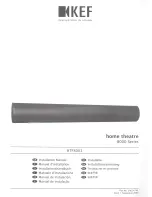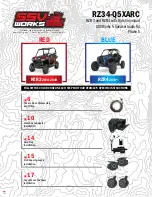
Another Owner’s Manual (Yawn)
We’ve tried to make this manual as easy to read and answer a lot of questions (except proba-
bly the ones that you’ll have) and you can always contact us. We’ll be happy to help. If you
already know about speakers, be our guest and start enjoying your RSL Speakers.
Since we don’t know about your particular audio setup, whether it’s home theater or stereo,
we’ve tried to cover all the bases. So feel free to skip around reading only what’s of interest.
2
A
Few
Words
of
Introduction
We’ve
been
building
speakers
since
1970.
A
few
years
ago,
we
introduced
a
home
theater
sys-
tem
that
garnered
rave
reviews
for
being
the
best
sound
value
in
at
its
price.
We
then
em-
barked
upon
a
mission
to
provide
that
same
level
of
sound
quality
at
a
more
affordable
price.
The
CG3
M
and
CG23
M
are
the
result.
It
took
a
lot
of
testing
and
comparing
with
other
brands
of
speakers
to
make
sure
that
we
could
offer
a
product
that
delivered
the
highest
level
of
sound
in
its
class.
Along
with
our
recently
introduced
Speedwoofer
10S
subwoofer,
we’re
now
able
to
provide
speakers
that
will
astonish,
especially
when
considering
price.
When
coupled
with
a
subwoofer,
such
as
our
Speedwoofer
10S,
you
can
expect
high-end
performance.
Compression
Guide
Technology
-
Action-Packed
History
A
2-way
speaker
utilizing
a
dynamic
woofer
and
soft
dome
tweeter
is
not
unique.
However,
what
make
these
speakers
a
game-changer
is
our
exclusive
Compression
Guide
Technology.
It’s
why
the
CG3
M
and
CG23
M
sound
different
from
the
vast
majority
of
speaker
systems.
Many
speakers
try
to
appeal
to
the
less
sophisticated
listener
by
exaggerating
certain
sounds
that
result
in
sound
that
we
call,
“in
your
face.”
This
approach
may
initially
seem
impressive,
but
along
with
it
is
a
lack
of
depth
or
dimensionality
in
the
sound
image
or
soundstage.
It
can
also
be
fatiguing
during
extended
listening.
With
RSL’s
Compression
Guide
Technology,
the
sound
is
less
like
speakers
and
more
lifelike
as
if
the
performance
is
actually
happening
in
your
room.
They
reproduce
whatever
sounds
are
fed
to
them
and
don’t
add
‘their
take’
on
them
as
many
speakers
do.
A
number
of
years
ago,
we
noticed
that
almost
all
speakers
(including
early
RSLs)
suffered
from
a
problem.
It
was
that
bass
notes,
when
reproduced
by
speakers
was
quite
different
from
bass
at
a
live
performance.
When
you’d
hear
bass
live,
you
would
hear
various
details
in
the
bass
as
well
as
feel
the
impact.



































